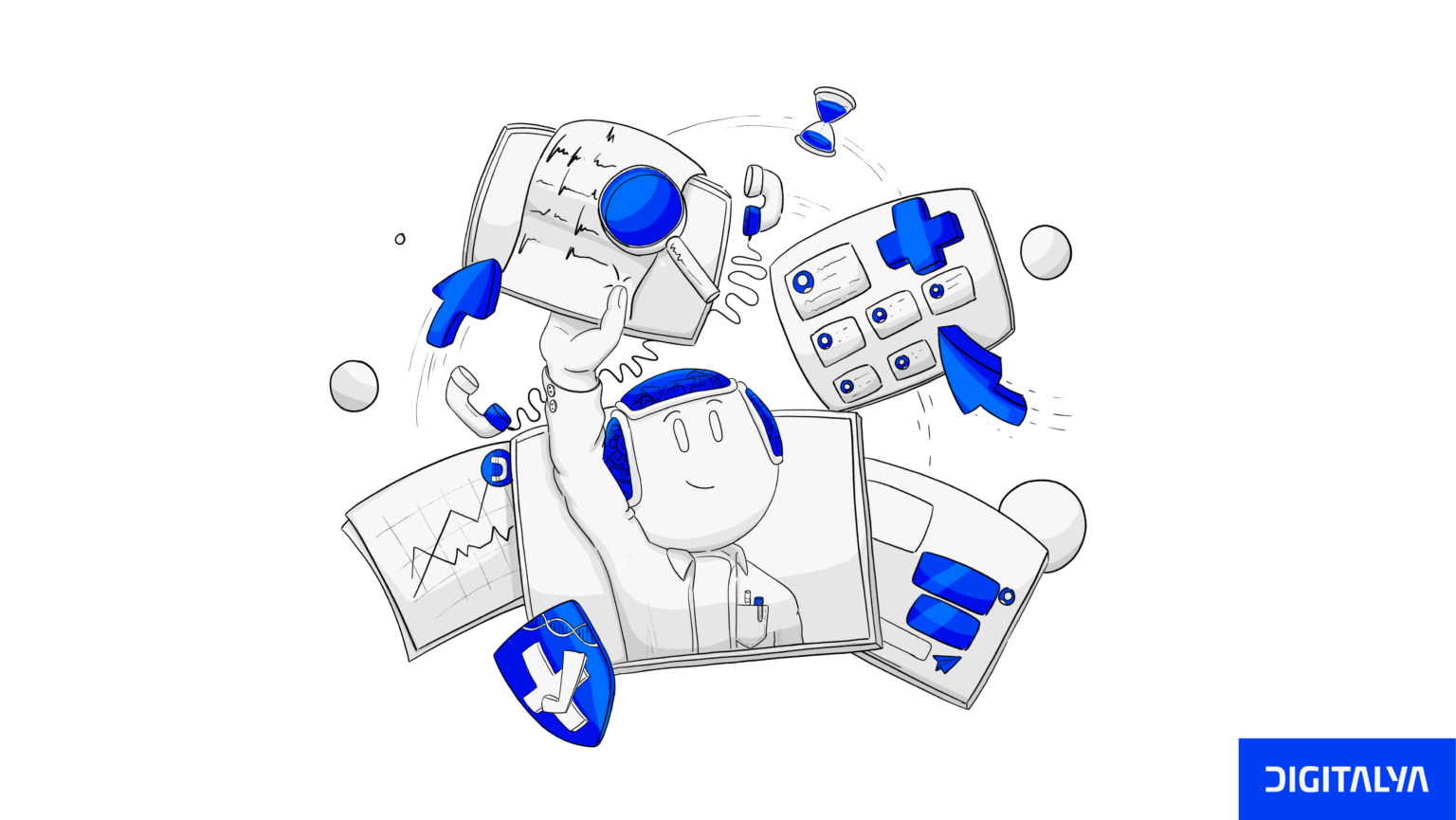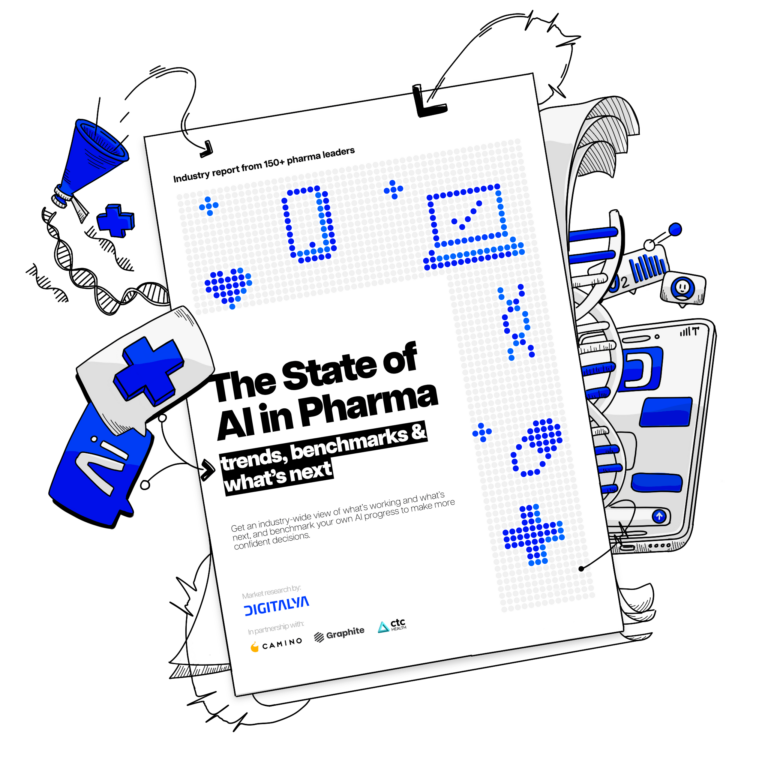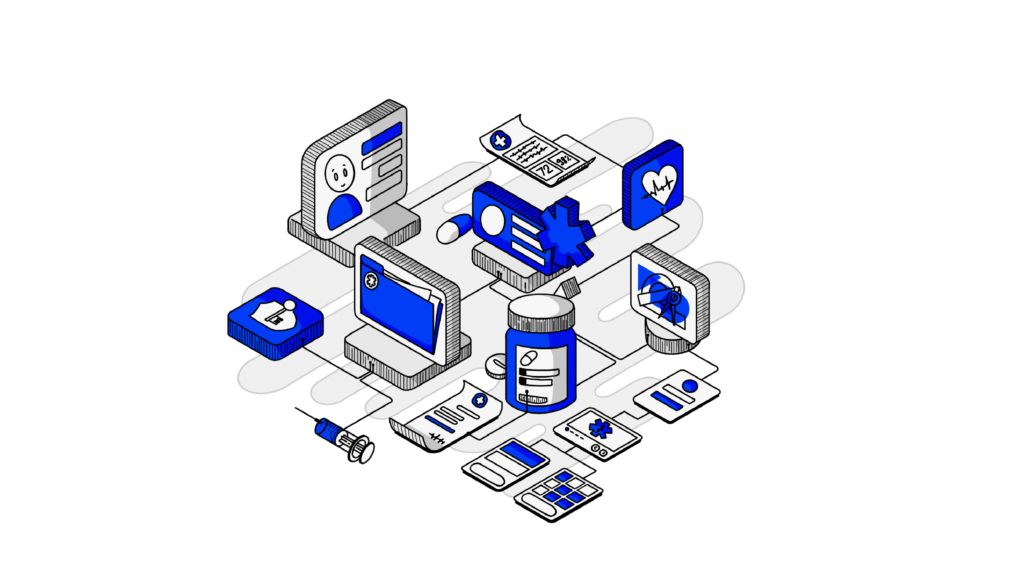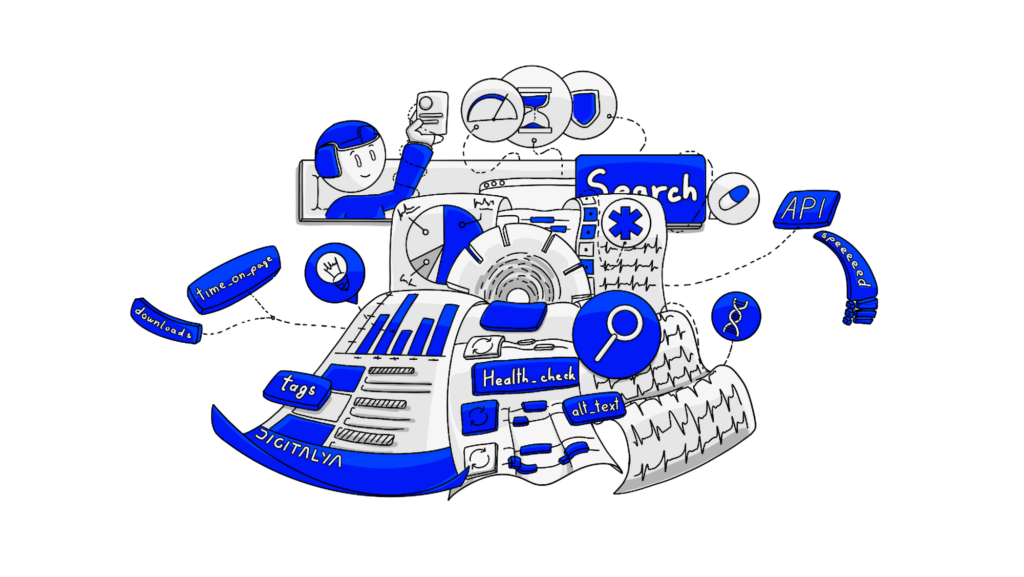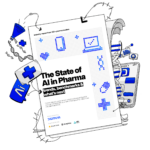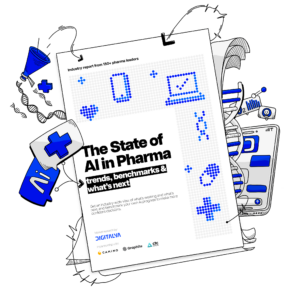1. The role of AI chatbots in streamlining internal operations
By leveraging natural language processing (NLP) and machine learning, these chatbots can automate various tasks, enhance communication, and provide real-time insights, ultimately improving overall efficiency and productivity.
- Automating routine tasks
AI chatbots can handle repetitive and time-consuming tasks like data entry, report generation, and customer queries. This, for example, would allow sales and marketing teams to focus on strategy and relationship building rather than administrative duties. Chatbots can also assist in compiling and organizing clinical data, ensuring compliance with regulations without overwhelming staff.
- Enhancing data access and management
Chatbots in pharma can serve as intuitive interfaces for accessing critical information. They can retrieve documents, provide updates on ongoing projects, and facilitate data sharing between departments. This immediate access to information reduces delays and empowers teams to make informed decisions quickly.
- Improving cross-departmental communication
An AI chatbot can serve as a centralized communication hub, ensuring information flows smoothly between departments. By streamlining inquiries and sharing relevant updates, pharma chatbots can help mitigate misunderstandings and foster a culture of collaboration.
- Supporting compliance and quality assurance
Regulatory compliance is a significant concern in the pharmaceutical industry. AI chatbots can assist in ensuring that documentation meets compliance standards, automate reminders for regulatory submissions, and provide guidance on best practices. Chatbots can enhance quality assurance processes across departments by minimizing human error and maintaining meticulous records.
- Facilitating real-time insights for decision making
Having timely and accurate information is crucial for strategic decision-making. Chatbots can provide real-time analytics, market trends, and performance metrics. This access allows data-driven decisions to be made that align with the company’s goals and respond swiftly to market changes.
2. Key challenges in pharma’s internal processes
The pharmaceutical industry is characterized by its complexity and regulatory scrutiny, which can lead to several internal challenges. Understanding these obstacles is essential for effectively implementing AI chatbots and other solutions to streamline operations.
2.1 Sales and marketing coordination
Effective sales and marketing coordination is crucial for a pharma company that aims to achieve commercial success. It can drive impactful strategies and enhance overall performance. However, several challenges hinder this coordination:
- Misalignment of goals and strategies — this disconnect can result in fragmented messaging and wasted resources. This can be improved by leveraging AI-driven analytics to provide real-time data on campaign performance and sales results.
- Data silos — fragmented data can make it difficult to access the insights needed for effective strategies. AI chatbots can provide instant access to product updates, marketing materials, and performance metrics.
- Rapid market changes — the pharma market is dynamic, which means sales and marketing teams must be agile and responsive to changes to capitalize on new opportunities.
2.2 CRM management
Customer Relationship Management (CRM) is essential for building and maintaining strong relationships with HCPs, clients, and other stakeholders. Effective CRM management can empower commercial teams with insights into customer behavior, streamline engagement, and ultimately enhance sales effectiveness. Let’s discuss the most common set of challenges:
- Complex customer segmentation — effective CRM management requires advanced segmentation to ensure tailored communications and targeted engagement strategies. AI chatbots can help segment customers based on behavioral data, preferences, and engagement history.
- Data volume and quality — ensuring data accuracy and relevancy is critical for effective CRM management, as incorrect or outdated information can lead to ineffective communication and lost opportunities. Leveraging the potential of chatbots can reduce manual errors and improve data quality. Automated data quality checks can help ensure that CRM data remains up-to-date, accurate, and relevant.
- Regulatory compliance — it’s essential for CRM systems to support compliance, which includes tracking and documenting engagements, managing permissions, and ensuring transparency in communications. An AI solution can provide automated compliance tracking.
- Consistency in customer engagement — many pharma companies struggle to maintain regular interactions. AI chatbots can prompt sales teams with follow-up reminders, personalized engagement tips, and alerts for critical account updates.
2.3 Data-driven decision-making and strategic oversight
With the proliferation of data sources, from clinical trial results to market insights and regulatory updates, a pharma company has unprecedented opportunities to make more informed, strategic decisions. This, in turn, enables pharmaceutical companies to optimize resource allocation, enhance commercial performance, and respond proactively to market changes.
- Data overload and signal extraction — massive amounts of data are generated, and identifying actionable insights among overwhelming volumes of information can be difficult. Machine learning algorithms can detect patterns, forecast trends, and highlight critical data points, simplifying making strategic decisions based on predictive insights.
- Integrating diverse data sources — strategic oversight requires data from multiple sources, including R&D, clinical trials, regulatory bodies, and marketing intelligence. Integrating this data for a holistic view is complex, as it may be housed in disparate systems with varying formats and standards.
- Balancing agility and compliance — while data-driven strategies can help companies react faster to market changes, regulatory requirements may constrain the speed at which insights can be actioned. Ensuring data-driven decisions meet compliance standards without sacrificing agility is a constant balancing act.
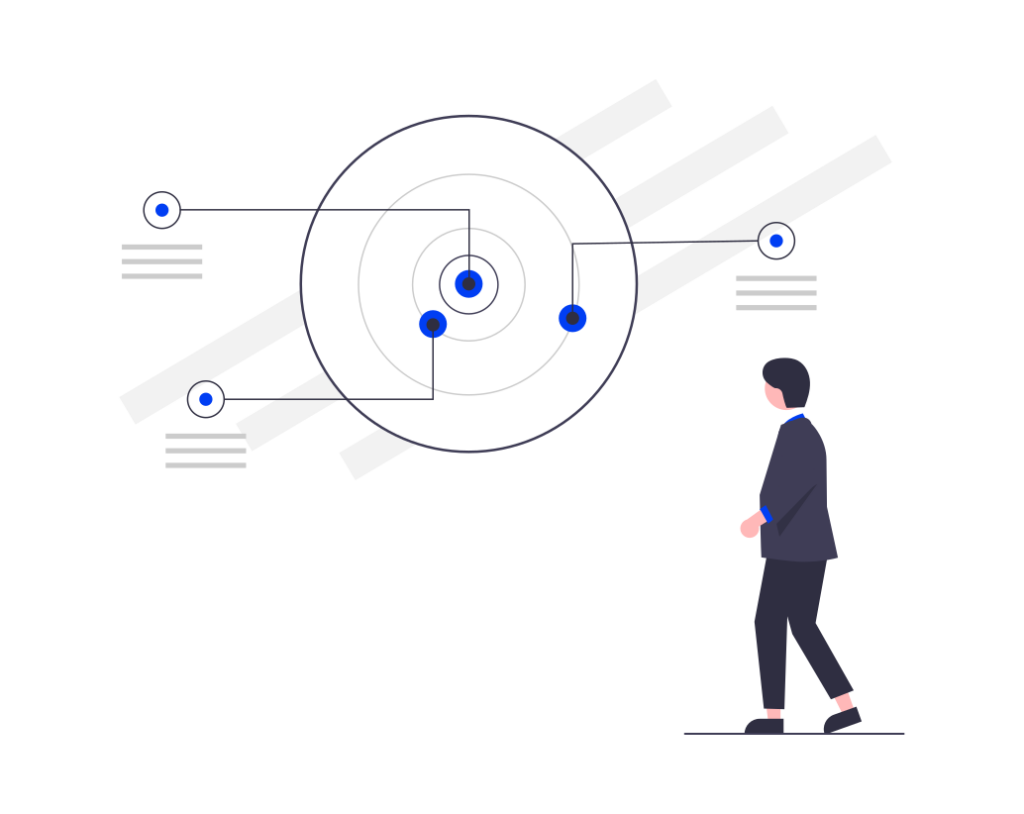
3. AI Chatbots in commercial operations
Commercial operations teams drive pharmaceutical product awareness, manage relationships with healthcare providers, and enhance sales efficiency. AI chatbots are transforming these functions by streamlining tasks, delivering valuable insights, and enabling real-time communication.
Pharma chatbots can boost commercial productivity, enhance customer engagement, and facilitate data-driven decision-making by automating repetitive processes and providing immediate support.
3.1 Automating CRM systems
Manually updating CRM data and extracting actionable insights can be time-intensive and prone to error. AI chatbots enhance CRM functionality by automating data entry, optimizing workflows, and providing real-time analytics. This automation streamlines CRM processes, improves data quality, and enables commercial teams to focus on high-value interactions rather than administrative tasks.
- Automated data entry and updates — automatically logging conversation details, customer preferences, and engagement outcomes directly into the CRM system. Whether it’s a product inquiry, feedback from healthcare providers, or follow-up requirements, AI chatbots capture and store this information in real time, keeping CRM records accurate and up-to-date without requiring additional manual input.
- Intelligent lead management — qualify leads by interacting with potential customers and gathering relevant data points, such as specialty, needs, and engagement preferences. After qualifying leads, chatbots assign them to appropriate sales representatives based on their probability of conversion, allowing the CRM system to prioritize leads effectively.
- Customer segmentation and personalization — using natural language processing (NLP) to gather information from interactions aids in segmenting customers in the CRM system according to their needs, behaviors, and preferences.
- Automated reminders and follow-ups — ensuring timely follow-ups with a healthcare professional and other customers is critical to maintaining strong relationships. AI chatbots can automate reminders and follow-up messages, notifying sales teams when it’s time to reconnect or respond to inquiries.
- Real-time data insights and reporting — analyze customer interactions and provide real-time insights on engagement trends, customer preferences, and emerging trends. By aggregating these insights directly within the CRM system, chatbots can generate reports and analytics dashboards that offer a high-level view of KPIs.
3.2 Enhancing sales forecasting and market analysis
Sales forecasting and market analysis are critical for the pharma industry to aid in planning product demand, allocating resources effectively, and responding to pharma market changes. AI chatbots, equipped with advanced data analysis and NLP capabilities, are revolutionizing these processes by automating data collection, identifying trends, and delivering insights in real time.
- Automated data collection from multiple sources — streamline data collection by interacting with healthcare professionals, patient interactions, clinical feedback, and regulatory changes.
- Real-time trend identification — use natural language processing to analyze customer conversations, enabling them to detect emerging trends and shifting customer preferences in real-time.
- Predictive sales forecasting—AI chatbots can perform predictive analytics to project future sales volumes based on historical data, current market conditions, and customer interactions. They apply machine learning to identify data patterns, allowing them to generate accurate sales forecasts.
3.3 Supporting sales teams with real-time data and product insights
By streamlining information access, AI chatbots empower sales representatives to provide informed responses during engagements, improve productivity, and ultimately drive better customer relationships.
- Instant access to product information — offer quick access to product information, such as dosing, efficacy data, side effects, and updates on clinical trials. Sales reps can query the chatbot directly from their devices, allowing them to provide accurate answers to HCPs instantly.
- On-demand analytics and performance metrics — AI chatbots equipped with analytics capabilities allow sales representatives to check their performance metrics on demand. Reps can ask for insights on their sales figures, customer engagement patterns, or regional performance.
- Efficient scheduling and task management — AI chatbots can act as personal assistants for sales reps, helping with scheduling, task reminders, and meeting preparation. They can suggest the best times to reach out to specific HCPs based on previous engagement history and can remind reps of follow-up tasks.

4. AI Chatbots in medical departments
AI chatbots can enable more efficient communication, streamline data management, and disseminate clinical information. By handling routine tasks and providing insights in real time, AI chatbots free up medical teams to focus on high-value activities, such as strategic research and patient safety.
4.1 Simplifying medical documentation and reporting
Medical documentation and reporting are critical yet resource-intensive activities within pharma companies. Accurate documentation is essential for compliance, patient safety, and quality control, but the manual nature of these tasks often leads to inefficiencies.
- Automated data entry and documentation — automatically log interactions, treatment notes, and data points into electronic health records (EHRs) or internal databases. When HCPs or internal staff provide updates or submit inquiries, chatbots capture this information and store it in a structured, standardized format.
- Standardized reporting and formatting — consistent formatting in medical documentation is essential for readability and regulatory compliance. AI chatbots can streamline this process by automatically applying formatting guidelines to reports, ensuring all documentation follows the same standards.
- Assisting with adverse event (AE) and safety reporting — chatbots in pharmacy facilitate AE reporting by guiding HCPs, patients, or internal teams through standardized reporting forms. Chatbots can ask relevant questions to ensure all required information is captured, store the data securely, and route it for further investigation if needed.
- Automated summarization of clinical data — NLP technologies can analyze and summarize complex data, condensing it into easily digestible formats.
- Quick access to regulatory guidelines and protocols — AI chatbots can help medical teams access the latest regulatory guidelines, protocols, and documentation standards on demand. By integrating with regulatory databases, chatbots can offer instant access to the most current requirements.
- Simplifying collaboration and record keeping — chatbots in pharma can assist with record management by organizing and indexing documentation for easy retrieval. When multiple departments collaborate on medical reports, such as clinical trial findings or patient case studies, chatbots ensure version control and provide team members with the latest document updates.
4.2 Streamlining cross-departmental communication for medical affairs
Medical affairs teams play a central role in ensuring accurate and compliant communication across various departments in pharma companies, including commercial, regulatory, and R&D. With a continuous need to share critical updates, insights, and medical data, effective cross-departmental communication is essential for delivering consistent and accurate information.
- Centralized knowledge repository — offers on-demand access to the latest research findings, clinical guidelines, and product information.
- Standardized messaging and compliance — consistent messaging is essential for regulatory compliance and effective cross-functional communication. AI chatbots can provide standardized responses for common inquiries, ensuring that all departments share accurate and compliant information about products, safety data, and research findings.
- Real-time responses to clinical or product inquiries — AI chatbots enable medical affairs to respond quickly to queries from various departments, reducing the need for email chains or meetings.
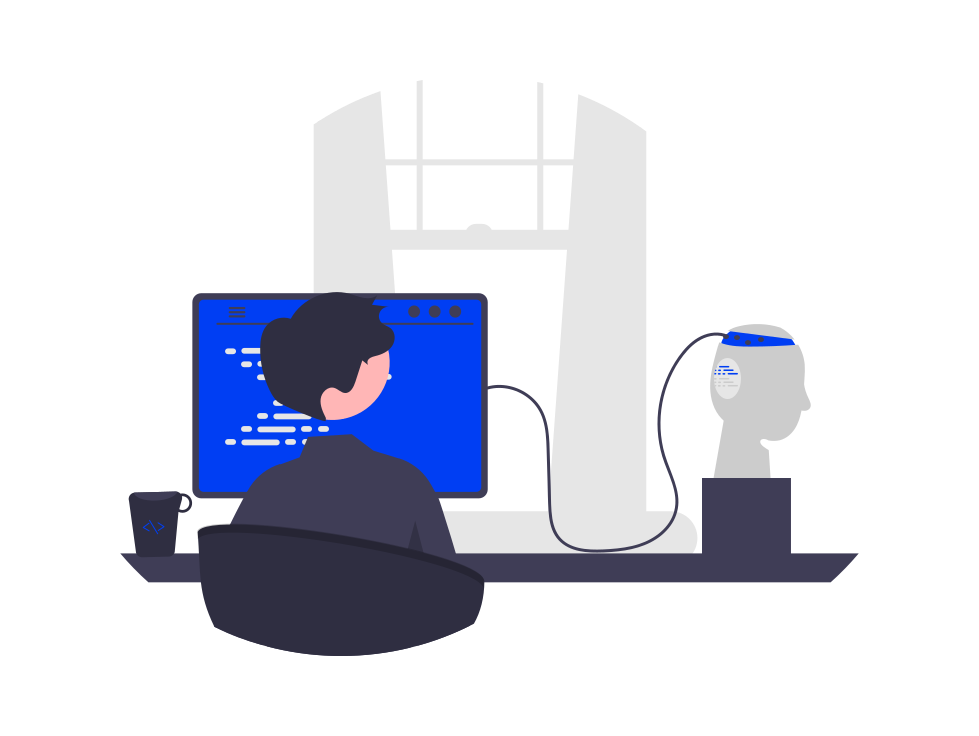
5. AI Chatbots in decision-making
In the healthcare industries, decision-making requires access to large volumes of complex data, including clinical research findings, regulatory updates, and market trends. AI chatbots are becoming valuable tools to support informed, data-driven decision-making across departments.
5.1 Providing real-time insights and reports
Real-time access to insights and reports is crucial for making informed decisions and staying competitive. AI chatbots streamline this process by providing up-to-date information across clinical, commercial, and regulatory domains.
With the ability to pull data from multiple sources and generate customized reports instantly, AI chatbots enable teams to access valuable insights when they need them most, supporting agile and data-driven decision-making.
- Instant access to KPIs — critical KPIs can be monitored in real time, from sales metrics to clinical trial progress. By integrating with internal data sources, chatbots can provide an instant snapshot of performance metrics such as product sales, market share, or patient recruitment numbers in trials.
- Providing predictive insights for strategic planning — advanced AI chatbots equipped with predictive analytics can generate forecasts and trends based on historical data, which is invaluable for strategic planning. This information helps leaders set informed goals, allocate resources effectively, and develop product launch strategies based on anticipated market movements.
- Data aggregation and real-time analysis — access and aggregate data from multiple internal and external sources, including clinical trial databases, market reports, and regulatory updates through chatbots technology. By instantly presenting relevant insights, chatbots enable decision-makers to access a real-time overview of essential information.
- Customer insights and market feedback integration — AI chatbots also support decision-making by gathering and summarizing pharmaceutical customers insights from HCPs, patients, and sales teams.
5.2 Automating routine strategic decision support
Routine strategic decision-making often involves analyzing large volumes of data, identifying trends, and aligning with regulatory standards. AI chatbots can automate many of these routine decision support tasks, enabling teams to focus on higher-level strategy while ensuring that every decision is data-driven and compliant.
- Routine data analysis and trend identification — automatically analyze historical data to identify emerging trends and patterns that are relevant to strategic decision-making.
- Automated reporting on key metrics — chatbots can deliver regular updates on KPIs like market share, trial enrollment, or regulatory submission timelines. They can also highlight significant shifts or anomalies in data, alerting stakeholders when performance trends warrant strategic attention. This way, teams can quickly identify where resources are most needed and adjust strategies accordingly.
- Real-time competitive analysis — track competitor activities, clinical advancements, and market trends to keep teams informed about their strategic positioning. By continuously monitoring competitor data from publicly available sources, chatbots provide insights into competitive strengths, potential threats, and emerging market opportunities.
5.3 Enhancing communication between executives and departments
Effective communication between executives and departments is essential for aligning strategic goals, improving transparency, and ensuring timely decision-making in pharma organizations.
However, communicating effectively across multiple levels of the organization can be challenging due to complex workflows and data silos. AI chatbots bridge this gap by providing a streamlined communication channel that ensures executives and departments can access and share information more efficiently.
- Real-time updates and notifications — AI chatbots can push real-time updates and notifications and relevant departments, keeping everyone informed about critical events, deadlines, or achievements.
- Centralized access to departmental data — rather than reaching out to department heads for routine inquiries, executives can query the chatbot directly for insights into sales performance, clinical trial progress, or regulatory status. This simplifies information retrieval, allowing execs to get a holistic view of operations and make better-informed strategic decisions.
- Facilitating crisis communication and incident management — in times of crisis or urgent incidents, timely communication between executives and departments is crucial. AI chatbots can provide a dedicated communication channel for incident reporting, instantly notifying executives and elevant stakeholders when critical issues arise.

6. Benefits of using AI chatbots for internal processes
Artificial intelligence chatbot implementation to support internal processes brings a range of advantages that enhance productivity, improve compliance, and streamline communication.
6.1 Faster sales cycles
AI chatbots can significantly accelerate sales cycles by streamlining processes, improving customer engagement, and providing real-time insights. Here are some key strategies to leverage AI chatbots to achieve faster sales cycles:
| Lead generation and qualification | Efficient prospecting and outreach | Streamlined sales process | Enhanced customer experience | Data-driven insights |
| Automated lead capture — AI chatbots can capture leads through website chatbots, social media, and email, ensuring no potential lead is missed. | Personalized outreach — AI chatbots can personalized outreach messages based on individual lead preferences and pain points, increasing engagement. | Automated scheduling — AI chatbots can schedule meetings and demos, reducing back-and-forth communication and accelerating the sales process | 24/7 support — AI chatbots can provide round-the-clock support, answering customer queries and resolving issues promptly. | Real-time analytics — AI chatbots can analyze customer interactions and sales data to provide real-time insights into sales trends and performance. |
| Rapid lead qualification — by asking targeted questions, chatbots can quickly qualify leads based on specific criteria, saving sales reps time. | Automated follow-ups — chatbots can automatically follow up with leads, send reminders, answer questions, and nurture relationships. | Product demonstrations — chatbots can provide product demos and answers questions, saving sales reps time and effort. | Personalized interactions — chatbots can tailor interactions to individual customer needs, improving satisfaction and loyalty. | Predictive analytics — by identifying patterns and trends, chatbots can predict future sales and optimize sales strategies. |
| Product demonstrations — chatbots can provide product demos and answer questions, saving sales reps time and effort. | Self-service options — AI-powered self-service portals can empower customers to find answers to their questions independently, reducing the burden on sales teams. | Sales forecasting — AI-powered forecasting tools can help sales teams accurately forecast sales and plan accordingly. |
6.2 Personalized customer engagement
By analyzing customer data in real-time, chatbots can deliver highly relevant information and support at every stage of the customer journey, enhancing satisfaction, trust, and long-term loyalty.
- Personalized recommendations — by analyzing customer history and preferences, chatbots can suggest relevant personalized content, such as blog posts, articles, or videos, based on user intent.
- Tailored marketing campaigns — chatbots can deliver targeted marketing messages to specific customer segments. Also, artificial intelligence can dynamically adjust marketing content based on real-time customer behavior and preferences.
- Proactive customer support — by analyzing user data, chatbots can proactively identify potential issues and offer solutions. Additionally, chatbots can provide personalized support, addressing specific needs and concerns.
- Enhanced customer experience — chatbots can provide round-the-clock support, ensuring users get help whenever they need it. In addition, AI chatbots can seamlessly transition between different channels, such as chat, email, and social media. By analyzing tone and sentiment, they can also respond empathetically cu user inquiries and complaints.
- Customer feedback and insights — chatbots can collect real-time feedback from users, enabling pharma companies to identify areas for improvement. Also, AI can analyze customer feedback to gauge sentiment and identify trends. By tracking customer interactions, chatbots can also provide insights into the customer journey, helping businesses optimize their strategies.
6.3 Improved data accuracy
Chatbots in pharma can significantly improve data accuracy by automating data entry, validating data, and identifying errors. By capturing data directly from various sources, chatbots reduce manual input and minimize errors.
They can also validate data in real time, ensuring accuracy and consistency. Additionally, AI chatbots can identify anomalies and outliers in data, flagging them for further investigation. By automating data cleaning and standardization, chatbots can improve data quality and enable more reliable data-driven insights.
6.4 Reduced compliance risks
By providing standardized responses to queries, chatbots minimize the risk of human error and misinterpretation. Also, they can be programmed to adhere to specific regulations and compliance standards, reducing the likelihood of non-compliance.
AI chatbots can also help identify potential compliance issues by analyzing data and flagging anomalies. By automating compliance tasks and providing accurate information, AI chatbots can help organizations maintain regulatory compliance and avoid costly penalties.
6.5 Efficient resource allocation
Resource allocation optimization can be done by analyzing data and identifying patterns. By predicting future demand and resource needs, chatbots can help pharma companies allocate resources efficiently.
For example, in a manufacturing setting, chatbots can analyze production data to identify bottlenecks and optimize resource utilization.
By providing real-time insights and recommendations, AI chatbots can help organizations make informed decisions about resource allocation, improving efficiency and reducing costs.
6.6 Informed strategic planning
AI chatbots can provide valuable insights to inform strategic planning by analyzing large amounts of data and identifying trends. By monitoring market trends, customer behavior, and competitive landscapes, AI chatbots can help businesses make informed decisions about product development, marketing strategies, and business expansion.
Additionally, AI chatbots can forecast future trends and potential risks, enabling pharma companies to proactively adapt to changing market conditions. By providing data-driven insights and recommendations, AI chatbots can empower organizations to make strategic decisions that drive growth and success.

7. The future of AI chatbots in streamlining internal operations
As integrating AI in the pharma industry continues to advance, chatbots will become sophisticated, capable of handling increasingly complex tasks. They will seamlessly integrate with existing systems, providing real-time data and insights to inform decision-making.
Chatbots will play a crucial role in automating routine tasks, such as data entry, report generation, and customer service inquiries. This will free up employees to focus on more strategic and creative work, boosting overall productivity and efficiency.
Additionally, AI chatbots will enhance collaboration and knowledge sharing within organizations. They can facilitate communication between teams, provide instant access to information, and foster a more connected and informed workforce.
As AI chatbots evolve, they will become indispensable tools for streamlining internal operations, driving innovation, and achieving sustainable growth.
